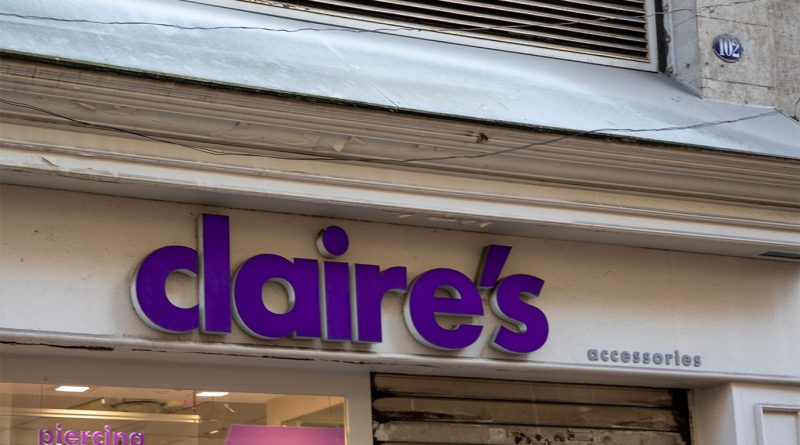Facing debt and declining sales, Claire’s files for bankruptcy protection
Subscribe to our free newsletter today to keep up to date with the latest retail news.
Claire’s Stores Inc., the long-standing accessories retailer beloved by generations of teens, has filed for Chapter 11 bankruptcy protection in the United States for the second time in seven years. The company listed both assets and liabilities between $1 billion and $10 billion in its petition with the U.S. Bankruptcy Court in Delaware. The filing impacts the company’s U.S. and Gibraltar-based subsidiaries, while operations in other regions, such as the U.K. and France, face parallel challenges.
The company attributed the move to unsustainable debt burdens, rising operational costs, and a rapid shift in consumer behavior. In a statement, Claire’s CEO Chris Cramer said the decision to seek protection was “difficult but necessary,” emphasizing that the company would remain operational during restructuring while continuing conversations with creditors and potential strategic partners.
Claire’s had previously emerged from bankruptcy in 2018 under new ownership backed by private equity. At the time, it aimed to streamline its operations and shift from a mall-heavy footprint to a more diversified omnichannel model. However, economic headwinds, declining mall traffic, and evolving retail preferences have again placed strain on the brand’s finances.
Structural Pressures and an Aging Debt Profile
At the center of Claire’s financial crisis is a nearly $500 million loan due in December 2026. The maturing debt, combined with rising interest rates, left the company with limited room for maneuver. Additionally, import tariffs have raised the cost of goods sold, impacting the bottom line. In filings, Claire’s noted that inflationary pressures and supply chain disruptions further weakened its recovery from the pandemic-era slowdown.
Despite efforts to modernize and extend its reach through e-commerce and third-party retail partnerships, the brand has struggled to reclaim the market share it once commanded. Store closures and revenue volatility have become regular features of its operations, especially in suburban malls where foot traffic continues to decline.
The company has also faced challenges in attracting its traditional teen demographic, which now shops across fast-fashion apps, online marketplaces, and social media platforms. Competing with highly agile brands that lean on influencers, TikTok trends, and limited drops, Claire’s has found itself outpaced and often overlooked.
A Global Story of Strain
Claire’s bankruptcy is not an isolated U.S. phenomenon. Its European operations are facing their own legal and financial hurdles. In France, the company’s subsidiary has entered a formal receivership process. The French commercial court confirmed the proceedings, known as “redressement judiciaire,” which allows for continued operations under court supervision while seeking a recovery plan.
In the United Kingdom, Claire’s has appointed financial advisers to explore strategic options. Those options may include a sale, further restructuring, or entry into insolvency proceedings. Retail analysts expect a decision within the coming months, depending on the outcome of U.S.-led negotiations and the brand’s ability to stabilize its international divisions.
The global nature of these challenges underscores the fragility of legacy retail models that have relied on high fixed costs, in-store experiences, and seasonal sales. Even as Claire’s pushed into new markets with franchise partnerships, the scale of its underlying liabilities became too much to bear.
Nostalgia Meets a Digital Retail Reality
For many consumers, the name Claire’s evokes mall trips, friendship bracelets, and first-time ear piercings. The brand has long held a nostalgic place in the cultural memory of millennials and Gen Z. Yet, this emotional connection has proven insufficient in a retail economy that increasingly values speed, personalization, and price competitiveness over tradition.
Unlike online-first competitors, Claire’s has struggled to pivot toward a digital model that matches its legacy identity. While it has made strides in launching online platforms and offering virtual styling tools, these efforts have yet to translate into consistent profitability.
Some analysts argue that the brand may still have life left—particularly as a licensing play or as part of a larger conglomerate’s retail portfolio. Others suggest that any recovery would require not just operational changes, but a complete rethinking of what Claire’s represents in today’s market.
The company has yet to announce concrete restructuring plans beyond its bankruptcy filing. However, it confirmed that stores will remain open for now, with business continuing as usual during the legal process. Stakeholders, including suppliers and landlords, are monitoring closely for updates that may impact operations and payment timelines.
Claire’s must now stabilize operations and adapt to shifting retail dynamics if it hopes to remain competitive in today’s market.
Sources:
